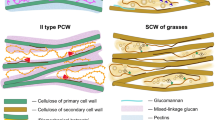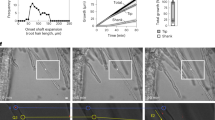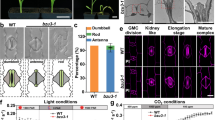Abstract
In plants, cell shape is defined by the cell wall, and changes in cell shape and size are dictated by modification of existing cell walls and deposition of newly synthesized cell-wall material1. In root hairs, expansion occurs by a process called tip growth, which is shared by root hairs, pollen tubes and fungal hyphae1. We show that cellulose-like polysaccharides are present in root-hair tips, and de novo synthesis of these polysaccharides is required for tip growth. We also find that eYFP–CSLD3 proteins, but not CESA cellulose synthases, localize to a polarized plasma-membrane domain in root hairs. Using biochemical methods and genetic complementation of a csld3 mutant with a chimaeric CSLD3 protein containing a CESA6 catalytic domain, we provide evidence that CSLD3 represents a distinct (1→4)-β-glucan synthase activity in apical plasma membranes during tip growth in root-hair cells.
This is a preview of subscription content, access via your institution
Access options
Subscribe to this journal
Receive 12 print issues and online access
$209.00 per year
only $17.42 per issue
Buy this article
- Purchase on Springer Link
- Instant access to full article PDF
Prices may be subject to local taxes which are calculated during checkout





Similar content being viewed by others
References
Cosgrove, D. J. Growth of the plant cell wall. Nat. Rev. Mol. Cell Biol. 6, 850–861 (2005).
Baskin, T. I. Anisotropic expansion of the plant cell wall. Annu. Rev. Cell Dev. Biol. 21, 203–222 (2005).
Arioli, T. et al. Molecular analysis of cellulose biosynthesis in Arabidopsis. Science 279, 717–720 (1998).
Fagard, M. et al. PROCUSTE1 encodes a cellulose synthase required for normal cell elongation specifically in roots and dark-grown hypocotyls of Arabidopsis. Plant Cell 12, 2409–2424 (2000).
Scheible, W. R. & Pauly, M. Glycosyltransferases and cell wall biosynthesis: novel players and insights. Curr. Opin. Plant Biol. 7, 285–295 (2004).
Taylor, N. G., Laurie, S. & Turner, S. R. Multiple cellulose synthase catalytic subunits are required for cellulose synthesis in Arabidopsis. Plant Cell 12, 2529–2540 (2000).
Taylor, N. G., Scheible, W. R., Cutler, S., Somerville, C. R. & Turner, S. R. The irregular xylem3 locus of Arabidopsis encodes a cellulose synthase required for secondary cell wall synthesis. Plant Cell 11, 769–780 (1999).
Taylor, N. G., Howells, R. M., Huttly, A. K., Vickers, K. & Turner, S. R. Interactions among three distinct CesA proteins essential for cellulose synthesis. Proc. Natl Acad. Sci. USA 100, 1450–1455 (2003).
Crowell, E. F. et al. Pausing of Golgi bodies on microtubules regulates secretion of cellulose synthase complexes in Arabidopsis. Plant Cell 21, 1141–1154 (2009).
Desprez, T. et al. Organization of cellulose synthase complexes involved in primary cell wall synthesis in Arabidopsis thaliana. Proc. Natl Acad. Sci. USA 104, 15572–15577 (2007).
Gutierrez, R., Lindeboom, J. J., Paredez, A. R., Emons, A. M. & Ehrhardt, D. W. Arabidopsis cortical microtubules position cellulose synthase delivery to the plasma membrane and interact with cellulose synthase trafficking compartments. Nat. Cell Biol. 11, 797–806 (2009).
Paredez, A. R., Somerville, C. R. & Ehrhardt, D. W. Visualization of cellulose synthase demonstrates functional association with microtubules. Science 312, 1491–1495 (2006).
Wightman, R. & Turner, S. Trafficking of the cellulose synthase complex in developing xylem vessels. Biochem. Soc. Trans. 38, 755–760 (2010).
Newcomb, E. H. & Bonnett, H. T. Cytoplasmic microtubules and cell wall microfibril orientation in root hairs of radish. J. Cell Biol. 27, 575–589 (1965).
Emons, A. Helicoidal microfibril deposition in a tip-growing cell and microtubule alignment during rip morphogenesis: a dry-cleaving and freeze-substitution study. Can. J. Bot. 67, 2401–2408 (1989).
Galway, M. E., Heckman, J. W. Jr & Schiefelbein, J. W. Growth and ultrastructure of Arabidopsis root hairs: the rhd3 mutation alters vacuole enlargement and tip growth. Planta 201, 209–218 (1997).
Desnos, T. et al. Procuste1 mutants identify two distinct genetic pathways controlling hypocotyl cell elongation, respectively in dark- and light-grown Arabidopsis seedlings. Development 122, 683–693 (1996).
Williamson, R. E. et al. Morphology of rsw1, a cellulose-deficient mutant of Arabidopsis thaliana. Protoplasma 215, 116–127 (2001).
Anderson, C. T., Carroll, A., Akhmetova, L. & Somerville, C. Real-time imaging of cellulose reorientation during cell wall expansion in Arabidopsis roots. Plant Physiol. 152, 787–796 (2010).
Blake, A. W. et al. Understanding the biological rationale for the diversity of cellulose-directed carbohydrate-binding modules in prokaryotic enzymes. J. Biol. Chem. 281, 29321–29329 (2006).
Emons, A. M. C. & van Maaren, N. Helicoidal cell wall texture in root hairs. Planta 170, 145–151 (1987).
Emons, A. M. C. Cell wall texture in root hairs of the genus equisetum. Can. J. Bot. 64, 2201–2206 (1986).
Carol, R. J. & Dolan, L. Building a hair: tip growth in Arabidopsis thaliana root hairs. Phil. Trans. R. Soc. Lond. B 357, 815–821 (2002).
Favery, B. et al. KOJAK encodes a cellulose synthase-like protein required for root hair cell morphogenesis in Arabidopsis. Genes Dev. 15, 79–89 (2001).
Rajangam, A. S. et al. MAP20, a microtubule-associated protein in the secondary cell walls of hybrid aspen, is a target of the cellulose synthesis inhibitor 2,6-dichlorobenzonitrile. Plant Physiol. 148, 1283–1294 (2008).
Cavalier, D. M. et al. Disrupting two Arabidopsis thaliana xylosyltransferase genes results in plants deficient in xyloglucan, a major primary cell wall component. Plant Cell 20, 1519–1537 (2008).
Galway, M. E., Eng, R. C., Schiefelbein, J. W. & Wasteneys, G. O. Root hair-specific disruption of cellulose and xyloglucan in AtCSLD3 mutants, and factors affecting the post-rupture resumption of mutant root hair growth. Planta 233, 985–999 (2011).
Birnbaum, K. et al. A gene expression map of the Arabidopsis root. Science 302, 1956–1960 (2003).
Brady, S. M. et al. A high-resolution root spatiotemporal map reveals dominant expression patterns. Science 318, 801–806 (2007).
Baskin, T. I., Betzner, A. S., Hoggart, R., Cork, A. & Williamson, R. E. Root morphology mutants in Arabidopsis thaliana. Aust. J. Plant Physiol. 19, 427–437 (1992).
Bernal, A. J. et al. Functional analysis of the cellulose synthase-like genes CSLD1, CSLD2, and CSLD4 in tip-growing Arabidopsis cells. Plant Physiol. 148, 1238–1253 (2008).
Zeng, W. & Keegstra, K. AtCSLD2 is an integral Golgi membrane protein with its N-terminus facing the cytosol. Planta 228, 823–838 (2008).
Bibikova, T. N., Blancaflor, E. B. & Gilroy, S. Microtubules regulate tip growth and orientation in root hairs of Arabidopsis thaliana. Plant J. 17, 657–665 (1999).
Preuss, M. L., Santos-Serna, J., Falbel, T. G., Bednarek, S. Y. & Nielsen, E. The Arabidopsis Rab GTPase RabA4b localizes to the tips of growing root hair cells. Plant Cell 16, 1589–1603 (2004).
DeBolt, S., Gutierrez, R., Ehrhardt, D. W. & Somerville, C. Nonmotile cellulose synthase subunits repeatedly accumulate within localized regions at the plasma membrane in Arabidopsis hypocotyl cells following 2,6-dichlorobenzonitrile treatment. Plant Physiol. 145, 334–338 (2007).
Desprez, T. et al. Resistance against herbicide isoxaben and cellulose deficiency caused by distinct mutations in same cellulose synthase isoform CESA6. Plant Physiol. 128, 482–490 (2002).
Scheible, W. R. et al. An Arabidopsis mutant resistant to thaxtomin A, a cellulose synthesis inhibitor from Streptomyces species. Plant Cell 15, 1781–1794 (2003).
Peng, L. et al. The experimental herbicide CGA 325′615 inhibits synthesis of crystalline cellulose and causes accumulation of non-crystalline β-1,4-glucan associated with CesA protein. Plant Physiol. 126, 981–992 (2001).
Bernal, A. J. et al. Disruption of ATCSLD5 results in reduced growth, reduced xylan and homogalacturonan synthase activity and altered xylan occurrence in βArabidopsis. Plant J. 52, 791–802 (2007).
Earley, K. W. et al. Gateway-compatible vectors for plant functional genomics and proteomics. Plant J. 45, 616–629 (2006).
Acknowledgements
The authors would like to thank C. Somerville and H. Hofte for sharing eYFP–CESA6- and eGFP–CESA3-transformed lines, C. Collins for providing access to the spinning-disc confocal microscope and O. Shafer for access to the Olympus Fluoview confocal microscope. We would also like to thank S. Clark, S. DeBolt, A. Liepman and J. Schiefelbein for discussions. This work was supported by grants from the Department of Energy, DE-FG02-07ER15887 (E.N.), and the National Science Foundation, 0937323 (E.N.).
Author information
Authors and Affiliations
Contributions
S.P. carried out most experiments. A.L.S., F. Gu, F. Guo and E.N. all contributed to experimental work and data analysis in this manuscript. E.N. was also responsible for project planning.
Corresponding author
Ethics declarations
Competing interests
The authors declare no competing financial interests.
Supplementary information
Supplementary Information
Supplementary Information (PDF 1170 kb)
Supplementary Movie 1
Supplementary Information (MOV 7387 kb)
Supplementary Movie 2a
Supplementary Information (MOV 7325 kb)
Supplementary Movie 2b
Supplementary Information (MOV 7391 kb)
Supplementary Movie 2c
Supplementary Information (MOV 6879 kb)
Supplementary Movie 3
Supplementary Information (MOV 1881 kb)
Supplementary Movie 4
Supplementary Information (MOV 966 kb)
Supplementary Movie 5
Supplementary Information (MOV 2089 kb)
Supplementary Movie 6
Supplementary Information (MOV 1250 kb)
Supplementary Movie 7
Supplementary Information (MOV 5440 kb)
Supplementary Movie 8a
Supplementary Information (MOV 641 kb)
Supplementary Movie 8b
Supplementary Information (MOV 802 kb)
Supplementary Movie 8c
Supplementary Information (MOV 967 kb)
Supplementary Movie 8d
Supplementary Information (MOV 1616 kb)
Supplementary Movie 9
Supplementary Information (MOV 2806 kb)
Supplementary Movie 10
Supplementary Information (MOV 2327 kb)
Supplementary Movie 11
Supplementary Information (MOV 2963 kb)
Supplementary Movie 12
Supplementary Information (MOV 1974 kb)
Rights and permissions
About this article
Cite this article
Park, S., Szumlanski, A., Gu, F. et al. A role for CSLD3 during cell-wall synthesis in apical plasma membranes of tip-growing root-hair cells. Nat Cell Biol 13, 973–980 (2011). https://doi.org/10.1038/ncb2294
Received:
Accepted:
Published:
Issue Date:
DOI: https://doi.org/10.1038/ncb2294
This article is cited by
-
Cytological, physiological and transcriptomic analysis of variegated Leaves in Primulina pungentisepala offspring
BMC Plant Biology (2022)
-
A combination of genome-wide association study and transcriptome analysis in leaf epidermis identifies candidate genes involved in cuticular wax biosynthesis in Brassica napus
BMC Plant Biology (2020)
-
Armadillo-repeat kinesin1 interacts with Arabidopsis atlastin RHD3 to move ER with plus-end of microtubules
Nature Communications (2020)
-
Plant cell wall integrity maintenance in model plants and crop species-relevant cell wall components and underlying guiding principles
Cellular and Molecular Life Sciences (2020)
-
Cotton CSLD3 restores cell elongation and cell wall integrity mainly by enhancing primary cellulose production in the Arabidopsis cesa6 mutant
Plant Molecular Biology (2019)



